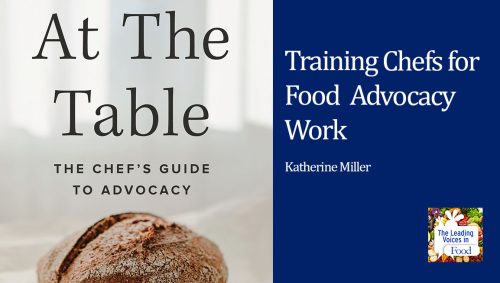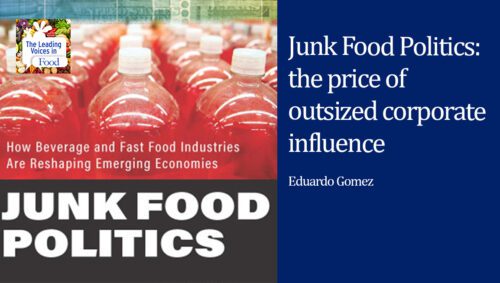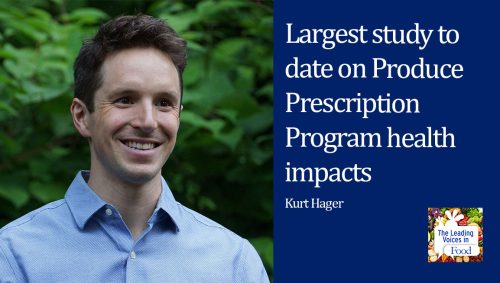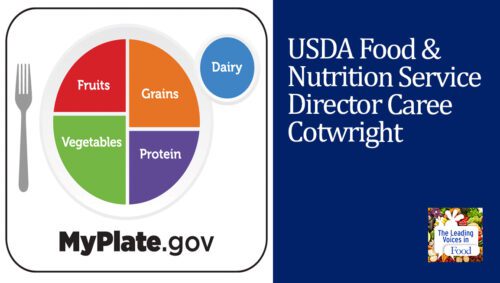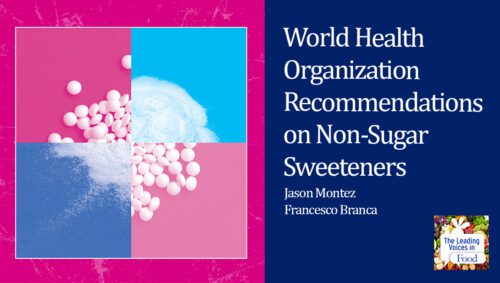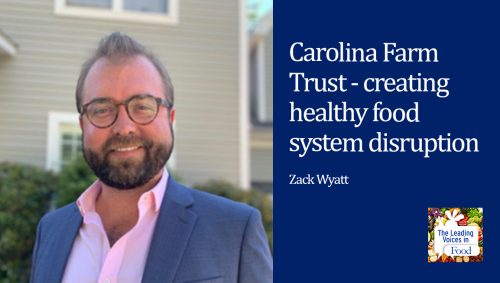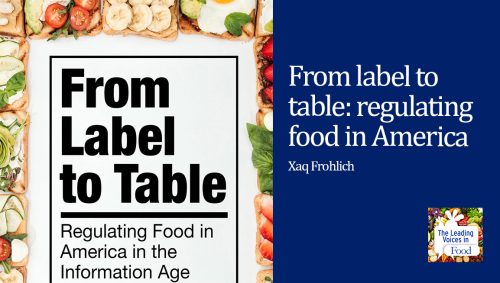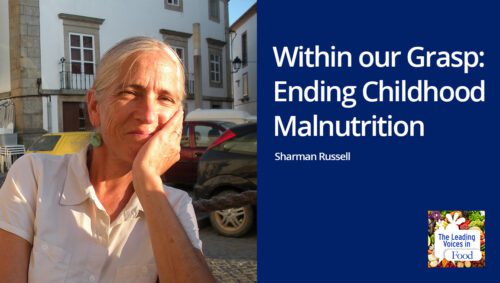The Leading Voices in Food
E1: Billy Shore on Feeding Kids in the US and Abroad
Have you ever wondered why people are hungry in a world that produces more than enough food to feed them? The Leading Voices in Food interviews Billy Shore, the executive chair of No Kid Hungry and its parent organization Share our Strength.
Subscribe: Apple Podcasts | TuneIN | Google Podcasts | SoundCloud | PocketCasts | Radio Public
Tags: Advocacy & Food | Child Development & Nutrition | Childhood Obesity | Diet & Nutrition | Food Insecurity | Food Policy | International Food & Ag Policy |

Billy Shore is the executive chair of No Kid Hungry and its parent organization Share our Strength. He and his sister Debbie founded Share our Strength in 1984 and led the organization in raising more than $600 million dollars to fight hunger and poverty. He spent the early years of his career in national politics serving on senatorial and presidential campaign staffs and serving as chief of staff to former US senator Robert Kerrey. He returned to the national stage in 2014 when Congress appointed him to the National Commission on Hunger, a bipartisan group given the task of agreeing on the best ways to effectively use existing programs and funds to address hunger in the United States.
Interview Summary
Why are people hungry in a world that produces enough food? How do we have hungry children in particular?
Yeah, especially in the United States. It really makes no sense and I wouldn’t have to give you probably even any facts or figures about hunger at all for you to say there’s no excuse for hunger in our country. Kids in America are not hungry for reasons that kids around the rest of the world are hungry. It’s not because of war or famine or drought, it’s not because of lack of food or in our case it’s not even because of lack of food programs. We have all of those and abundance. So what we failed to do is connect kids to these programs and these resources that exist for them.
I think it’s important to just think about hunger as the symptom of a deeper problem of poverty. And unfortunately the kind of structural poverty that exists in our country has meant that even when the economy is doing well as it is now, a lot of people still get left behind.
So let’s paint the domestic picture of food insecurity in the United States. Who’s most likely to be food insecure? How serious is the problem?
Well, we have focused mostly on children, so we’ve got one in six kids in this country who live in a household where there’s food insecurity. They’re not all food insecure themselves, but we’ve got 22 million kids on the school lunch program. So they’re getting a free or reduced price lunch based on their family’s income being a certain percentage of poverty, pretty much close to the poverty line, which is, let’s say $24,000 for a family of four.
So, you’ve got an awful lot of kids who were still dealing with hunger and, you know, at risk of if not missing meals at risk of having meals that are compromised nutritionally.
What is the geographic distribution of this look like? Urban, rural, both?
Yeah, hunger is pretty much everywhere now. Certainly urban and rural, certainly. There’s obviously concentrations of poverty in large urban areas. In some ways they’re actually easier to address him to service because you know, how to deliver the product to the kids, you know, where they are, as opposed to rural areas. I was just recently in rural Montana on a native American reservation and it is very hard to serve places like that. But it’s also old and young. It’s not any particular population. We focused on children because they’re not only the most vulnerable developmentally, but the least responsible for the situation that they’re in.
And the good news here, we’re kind of talking about the bad news…the good news is that it’s a solvable problem. One of the things we asked ourselves in the work we’re doing at Share our Strength is something that the writer Jonathon Kozol talks about, which is how do you pick up a problem that is big enough to matter but small enough to win. And so when we looked at all the things that we cared about, famine in Ethiopia and the Sudan and seniors who are hungry and veterans who are hungry when we looked at kids in the United States who were hungry on a chronic basis. That felt big enough to matter small enough to win. And it is a solvable problem because we’ve got these, particularly not just the food in this country, but food programs like school lunch, school breakfast or summer meals, the SNAP food stamp program and WIC.
A child may potentially live in a house where there’s food insecurity, but the child may not be food insecure. What does that suggest happening within a family?
Yeah, it suggests a lot of stresses in the family. And so you have much higher levels of household food insecurity than you do a child food insecurity because a lot of families that the adults would do what you expect them to do, which is to protect the kids. So they sacrifice a little bit. The number of kids who were actually missing meals now is getting down to a very small number. And since 2008, between 2008 and 2018, the number of kids who present with what our government calls very low food security, which is the most severe form of food insecurity, that number’s been cut in half. It’s now about 250,000 kids.
What is the impact on a child of food insecurity or common chronic malnutrition?
Well, I think there’s a whole set of impacts, some of which are physical, literally in terms of preventing them from growing as healthy as they should. The biggest impact that I think we see is the impact in schools. Kids who were not able to pay attention, not focused, not on time, not on task. But that’s changing. I was just at a school in San Francisco called Reading Elementary School and I got so excited about what I saw there because 99 percent of the kids live below the poverty line. Ninety nine percent. It’s on the edge of the Tenderloin neighborhood. Twelve percent of the kids are living in homeless facilities. Fifty percent of them have one parent who’s an immigrant. But none of them are hungry anymore.
Their school has breakfast, their school has a second chance breakfast–so if you can’t get there before school starts, which a lot of kids can’t there’s a breakfast between first and second period. They have a lunch program, and then they have an afterschool supper program. So what used to be almost like a sentence to be, you know, if you’re living with this kind of poverty, you’re almost sentenced to be hungry, now is no longer the case. And I think that’s what we’re starting to see in a lot of schools around the country.
Who pays for those services?
Well, it’s combination of public and private. The school meals programs are 100 percent federally reimbursed. And the big problem we’ve had in the big focus of our No Kid Hungry Campaign has been to make sure that everybody who’s eligible for these programs is participating.
So I mentioned 22 million kids getting a free or reduced price school launch. All $20 million are eligible for breakfast as well. But when we started focusing on this in 2008, only 9 million of the 22 million were getting breakfast. So why is that? Because at lunch they’re already there. At breakfast you have to get there earlier. Sometimes families can’t get their kids to school earlier based on mom and dad’s work schedule or the bus driver’s schedule. There’s the stigma attached to being the kids who go early to school and sit with all the other kids who had to go early as opposed to lunch when everybody’s there. So there’s a lot of reasons for this dropoff, but we found some very simple ways to fix it. The simplest of all being, if you move breakfast from the cafeteria to the first 10 minutes of first period the participation rates go up from half the kids getting breakfast.
About 95 percent of them getting breakfast. And so we’ve added 3 million kids to the school breakfast program just in the last six years. And we’ve seen all the things that you would want to see. Test scores, improving attendance, improving visit to the nurse’s office diminishing.
If one believes that children should be protected and that public funds should be used for this, if you begin with that premise, there are a lot of ways you can invest in children. You could try to improve the schools, you could do drug abuse prevention. Is addressing food and hunger related issues and especially good investment?
I think so. I think it’s one of the most fundamental ways to invest in kids. We just had a conversation with some foundation leaders who were asking us all kinds of questions about how we measure the results of feeding kids and have we measured test scores and have we measured improved attendance and so forth. And we have. And we’ve seen some very good results.
We had Deloitte do a study for us and it showed in the schools where we were working with these alternative breakfast programs, Math scores were 17 percent higher. Attendance rates were several days longer. But one of the things that I said to this group that was pressing us, and I appreciated their questions, was if we didn’t have these results, would you then be in favor of stopping feeding these kids? I mean, this is so fundamental and it’s so basic whether you have these positive metrics or not. I think everybody knows that it makes sense to feed kids as you send them off to try to learn for six or seven hours a day.
You’ve made a good argument for there being a moral imperative to do this to children just deserve access to food that can nurture them in so many ways. But then it also pays off in terms of improved test scores and performance in school and things.
I think that’s right. You know, James Baldwin, the author once said these are all our children and we will either profit or pay for whatever they become. We will profit by our pay for whatever they become. So it’s not just about feeding kids. This is about all of us, right? We all either suffer the consequences or reap the benefits if our kids are not in a position to join our economy, to be fully productive, to be good learners. All the rest.
There’s a big world of malnutrition and hunger and food insecurity outside the US. How does an organization like Share our Strength make decisions about deploying resources domestically and internationally?
Well when we started charity strength back in 1984, it was a consequence of the Ethiopian famine, which at the time was this terrible catastrophic humanitarian issue. And we ultimately got more focused on domestic work here in the US. In 1984, when we started, it was in the middle of the Reagan administration. There had been budget cuts and homelessness was on the increase in the United States. So we shifted most of our focus to domestic. And one of the things we found was that many of our donors and supporters wanted us to concentrate on our own backyard. But we still felt this pull to be working, this tug to be working internationally. And so we’re now in the process of kind of building that back. We’re working on some school meal programs in India, in Zambia, and some other places. It’s very hard to prioritize given the level of need outside the United States and I wouldn’t be as quick to say that it’s, as I said at the beginning of our conversation that it’s a solvable problem outside the United States.
Some of the poverty is so severe. But there are 58 countries now that have school meal programs and our government actually supports them. Some of the leaders in Congress who helped build the school lunch in the school breakfast program in the United States, on a bipartisan basis, senator George McGovern and Senator Bob Dole, one of the last things they did in their senate tenure was to create the McGovern Dole International Feeding Program, which is, I think administered by USAID or our State Department. And we actually help schools around the world to have the school meal programs that we have.
You were involved in the influential Commission on Hunger report that I mentioned in the introduction that was a bipartisan effort. Could you tell us about that?
Yeah. There was a congressman from Virginia who served for many years and right as he was leaving after maybe 25, 30 years in Congress, Frank Wolfe, cared about the issue of hunger.
He particularly cared about the issue of food waste and he had a inserted into, you know, one of these last minute, late night, nobody paying attention omnibus appropriations bills a provision that there should be a National Commission on Hunger to report to Congress on solutions for addressing hunger. And so there were 10 members, five of us appointed by the Republican leadership, five by the democratic leadership. And we went around the country actually, one of the things we were urged to do is not just sitting in a conference room, but go out and talk to people are hungry. Go to Arkansas, go to the Mississippi Delta, go to native American reservations. We traveled all over the country to try to bear witness to what the issues are, to see what people were struggling with and then to come back with some bipartisan solutions. So we ended up with a unanimous report that was very, very strongly in favor, surprisingly, given the number of a Republican colleagues I had on it, but very strong in favor of the SNAP food stamp program as one of the mainstays of how we fight hunger in this country. And a whole set of other recommendations around how to make sure that the foods that people are able to access through federal nutrition programs are healthier for them as well.
Bipartisan support seems to be in short supply these days. How in the world did five Democrats and Republicans coming together?
Yeah. Well, one of the first things we did is we said to ourselves, you know, this report will only get any attention at all is if we’re unanimous. If we make this statement, if we’re not like everything else that happens in Washington where half of us say one thing and have say another and nobody really knows who to believe. So, at every step in the, at every juncture in this kind of 18 month journey that we took together, we said no, we’ve got to make sure that we’re all together on this. And we argued things out. We spent a lot of time and we circulated drafts. It was almost like a process where like justices on some court would keep circulating opinions back and forth to each other and editing each other’s opinions till we got to some consensus. But I think it was worth it. And nobody, you know, nobody had an agenda. Nobody was trying to score political points.
What’s so frustrating today in the house or the Senate, and I’ve worked in the Senate for 13 years as you’d mentioned, is that there’s a reflexive opposition to whatever the other side proposes, almost blindly. And if you think about a chamber, again the Senate where almost every vote is 51 to 49, why even bother to go there if you’re not going to get to use your own brain in your own voice?
What was the impact of the report?
Well, it was, you know, like anything else, it was a somewhat incremental in terms of the changes, but a number of members of congress particularly who are active on hunger issues. Congresswoman Rosa Delauro, Congressman Jim McGovern, some governors around the country, a Republican governor of Nevada Sandoval, each took elements of it and tried to build it into their policy agendas.
I hear that you have an interesting story to tell about how breakfast, lunch, school, lunch and breakfast programs got started?
Yeah. Well, you know, they’re the main stay of our, our anti-hunger work now, but they really came about after World War II. I think it was in 1946, a group of generals and admirals came to Congress to testify that by the end of the war and say our troops were not healthy enough to fight. That they were too malnourished, that just weren’t strong enough literally. And so they said, you know, if we’re going to be prepared, if our nation is going to be prepared to fight a war, as long as World War II turned out to be, our involvement there was I guess about four years or a little bit more, we need to start investing in feeding kids and nourishing them.
We’ve done that as a country. But even today, only 25 percent of all American youth between the ages of 18 and 34 are fit to join the military. In some cases it’s obesity or malnutrition. In some cases it’s drug or alcohol addiction. In some cases it’s criminal records. But to think that in a world as dangerous as ours is now and how extended the United States is around the world, that only 25 percent of our youth are capable of serving, and of those issues that I described, the biggest one is a malnourishment and obesity.


